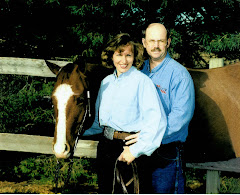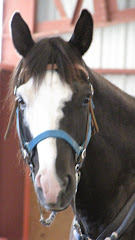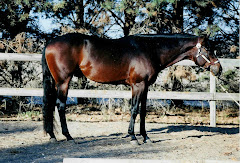 I enjoyed the book. “The Beginning Dressage Book” by K. Denby-Wrightson and J. Fry, and reading about the basics of dressage . I thought this book was very precise, yet easy to understand. The beginning rider, as well as the experienced horse person, will learn something from this book. Beginning Dressage, part 2, teaches correct, balanced riding and dressage exercises.
I enjoyed the book. “The Beginning Dressage Book” by K. Denby-Wrightson and J. Fry, and reading about the basics of dressage . I thought this book was very precise, yet easy to understand. The beginning rider, as well as the experienced horse person, will learn something from this book. Beginning Dressage, part 2, teaches correct, balanced riding and dressage exercises.Part 2 begins, at Chapter 11, to teach correct posting and the correct movement of the horse at the trot. The rising trot involves your seat, hips and thighs. The movement of the horse pushes you up and out of your seat. You allow your hips to move towards your hands. Your thighs roll forward as you raise your seat. Your legs and hands stay steady. Your legs remain at the girth and your elbows should be in line with the horse’s mouth. Your shoulders remain back, not leaning forward, as you should have a straight line from the back of your ear through to your shoulders, hips and heel. And, obviously, weight always remains in your heels.
Through my own experience, if you can’t keep your heels down, shorten your irons 2 notches. Remember that you are doubling over the iron leather as you are shortening the leathers, so 1 notch will actually only shorten the irons a ½ notch. You may need to shorten the leathers 2-4 notches. Also remember to keep your thighs relaxed! Instead of holding tight with your thighs, allow your thighs to move forward up and out of the saddle as you are posting. I always tell my lesson people that if you are tight, you will bounce like a ball full of air, and you will bounce hard! If you are relaxed, you will be like a ball ½ full of air and one that will hardly bounce!
I highlighted some interesting notes as I read the book. Some of these I knew and some of these ideas, as I read, I thought, “Huh, that’s right, I never realized that before“. Some of these thoughts are very basic and easy to understand, and some of these thoughts need to be analyzed, and practiced on the horse, to fully understand. I think I will work on 1 or 2 new ideas at a time.
The reason to post on the correct diagonal is so the horse can maintain greater impulsion. Your weight needs to be out of the saddle as the horse moves his inside hind leg. The hind leg will be able to get up and under the horse’s body more, therefore giving the horse more extension at the trot. A great trot is when the inside hind leg reaches up and is in the front hoof print, or even beyond the front hoof print.
Don’t use your feet to post. Don’t grip with your knees. Learn to post out of your seat. A great exercise is to post without irons. Cross the irons in front of you so they don’t sway and bump against your legs as you are trotting.
Another great exercise is to balance in 2-point position. Trot in 2 point position for 10 strides, then post for 10 strides. Do this same exercise while trotting over poles. Trotting poles also teaches a horse to pick up his feet, and trot with cadence.
You can also try posting, with and without irons, with your hands on your hips. Sit the trot and raise your hands over you head. Feel the trot THROUGH YOUR STOMACH and the small of your back. Push your stomach out as your raise and in as you sit. Feel the motion of the trot in your stomach and in your lower back.
Another exercise is to hold the reins in one hand and put your other hand on the pommel. Grip the pommel, straighten that arm, and push your shoulders away from your hand. Keep your seat in the saddle and stretch your body up and back. Feel the trot movement in your stomach and lower back. Move with the horse!
You ask for impulsion with your inside leg!!! Hold with the outside leg behind the girth and bump with your inside leg, at the girth, to ask for the canter. I will need to practice this as I always ask for the canter with my outside leg. I have always pushed with my outside leg to get more extension at the canter. Start by sitting deep in the saddle and use your seat bones to push the horse forward. Do this by doing the pommel exercise talked about in the preceding paragraph. Remember, during the canter, use your stomach and back muscles to follow the 1-2-3 rhythm of the canter.
In my past experience, to canter, I would push the hip to the inside. The horse engages the outside hind leg to push off with and into the correct lead. With the dressage method, your inside leg asks for impulsion, allowing room for the hind legs to step further underneath the horse. You sit more on your inside seat bones. To support the added weight to the inside hind leg, the horse must bring the inside hind leg further under the body.
Dressage allows the horse to use his own balance. The horse needs to be rounded and moving with rhythm. At the canter, the horse needs to bend in the direction that he is moving. The horse needs to be moving forward and straight, but before going forward, the horse needs to be balanced. When you engage the horse’s hindquarters, he lightens his forehand.
I have already been training with many of the dressage riding exercises. Leg yields move the horse diagonally across the arena while keeping the horse straight and parallel to the long wall, both at the walk and the trot. Serpentine the arena while changing the posting diagonal. Figure 8’s allow the horse to change the bend in the body. Ride circles, then spiral the circles in and out.
Teach the horse to travel straight. The hindquarters should travel directly in the same line as the forehand. The horse will be able to engage the hindquarters and use more impulsion. As the horse lengthens his stride, he lengthens his frame. Collection, on the other hand, teaches the horse to move forward with an engaged hindquarter and a lightened forehand, while maintaining cadence. Half halts teach the horse to hesitate during the movement of the gait, and teach the horse to use the hind legs.
The horse is working hard, both mentally and physically. Until the horse is in shape, keep work times to 15-20 minutes. Extend the work time as the horse builds endurance. The horse needs to stay confident while maintaining the form.
I want you to learn to ride through feel and to “get it”. When you have “it”, you will know what the “it” is. I promise! You will ride more comfortably and confidently. Come along on the ride of learning. Remember, move FORWARD and BALANCED, WITH INCREASED ENERGY AND COLLECTION!!! Read this book! I highly recommend “The Beginning Dressage Book”!







4 comments:
If you liked this book, I would suggest you read The Practical Dressage Manual by Bengt Ljunguist. This book is very nuts and bolts and is more true to the form of classical riding through feel. It also breaks down how and what you should be training as you increase your and your horses skills.
I thought the Begining Dressage book was an OK read, but once I started studying classical riding it has some gaps. But thats just my opinion and I applaud you for learning about the art of dressage!!
Thanks! Yes, for me, this book was easy to read and to understand. I was excited to read the riding section, but it just explained forward movement, with impulsion. The book didn't cover anything deeper than that. I will read this book that you are suggesting. I want to figure out the difference from this style and the higher level pleasure riding that I have taught. I think we all can learn from different disciplines. My husband said to me, "maybe there is more than 1 right way to accomplish the movement that you are looking for." I can't wait to figure that one out!
Brenda, that was a great blog! Cool exercises, I will give them a try. Pretty exciting stuff, this is a new frontier for me! I like the comment by 20 meter circle,too, another good book to read!
thanks!!! I can't wait to try some of the rider exercises too. I have already been training with most of these horse exercises. Now it's time to be more specific with how the horse responds! good luck with your spring riding too! I hope you have time, like I have found, to enjoy that special horse or 2! Yet, I hope you are able to continue your training too. Find what makes you happy and content!
Post a Comment